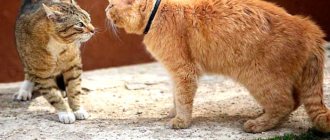Signs of aggression in cats
Before using any sedatives, you should consult a veterinarian.
The reaction to stress manifests itself differently in cats, and an inexperienced owner may not immediately recognize fear in the animal’s behavior.
When cats behave nervously:
- lick the skin on one side of the body (one paw, one side);
- calm themselves by making loud purring sounds;
- become completely indifferent to their favorite food or become overly gluttonous;
- They begin to gnaw on various objects and chew indoor flowers.
In case of severe fright due to a loud sound or the appearance of a dog, pets:
- they freeze in place, flattening their ears, tucking their paws and tail under them;
- attempt to escape;
- trying to hide in a dark, secluded place.
During an attack of aggression, small predators begin:
- arching the back to look larger, inflating the tail and hair on the body;
- hiss loudly, snort, howl, showing his teeth;
- look closely at the object that causes aggression;
- rhythmically whip the tail over the body, twitch it;
- hit an approaching object with the front paws with claws extended.
If a panic reaction occurs (if the cat was unable to hide or protect itself), the animal experiences:
- copious flow of saliva, similar to foam;
- loud scream, heartbreaking meow;
- involuntary urination.
Be sure to read:
Proper care of kittens at home in the first 1-2 months, what to do
Fighting aggression
Aggression occurs not only as a reaction to fear, but also for other reasons. Methods for calming a cat depend on the source of its anger.
How to recognize aggression
Most often, Pallas' cats, Savannah cats and Siamese cats show aggression. The following signs will help you recognize it:
- loud hissing and snorting;
- showing teeth;
- pressing the ears to the head;
- arching of the back;
- tail swelling;
- dilated pupils;
- release of claws.
If you notice that the cat is “on edge,” do not try to pet it. This can result in serious bites and deep scratches.
Methods to calm an angry animal
Act based on your specific situation. Every problem has its own solution:
- Pain. A sudden attack by a friendly and affectionate pet is most often explained by illness. If you haven't stepped on your cat's paw or pulled its tail, take it to the doctor.
- Territorial instinct. Battles for territory occur when several mature, uncastrated cats are kept together. The most reliable solution is surgical, that is, castration. Separating feeding areas and purchasing separate trays and beds can also help.
- Reaction to affection. Too frequent or overly active stroking quickly becomes boring and begins to irritate. Respect the interests of your pet and do not pet against its will.
- Fear. Provide the animal with a comfortable shelter and leave it alone.
- Rare games or ending too abruptly. Missing activity and unable to express its energy, the cat begins to throw itself on its legs and arms. The problem can be solved by increasing the frequency and duration of joint games, as well as by purchasing interactive toys.
- Protection of the cubs. A cat that has recently given birth can even attack its beloved owners. She needs to be given time to get used to the new role. For 2-3 weeks after birth, it is recommended not to disturb the pet over trifles and limit its communication with other household members.
- Unsatisfied sexual desire. It can occur in both male and female cats, but males show anger more often. An adult, uncastrated cat may well attack any person without warning under the influence of a sharp surge of hormones. If there are children living in the house, be sure to castrate or neuter your animal to avoid any trouble.
- Responsiveness. If a pet is beaten, it can respond in kind. The same reaction will occur to bullying or rough play.
Separately, it is worth noting cases of redirected aggression, when the target of the attack is not related to the real problem. Its main reason is the inaccessibility of the source of alarm: a sharp sound from the street, a bird or other animal outside the window.
Frequent attacks are treated only with sedatives, and isolated attacks are treated with emergency removal from the stressful place. To do this, use a thick blanket or other dense fabric that needs to be thrown over the angry cat.
It also happens that aggression is causeless - in this case we are talking about shifts in the psyche. Such deviations can only be treated under the supervision of a veterinarian.
How to identify the cause of anger in a cat
Irritability in adult animals is provoked by a painful condition.
Domestic cats, unlike dogs, have retained many qualities inherent in wild animals. Instinct tells them that danger can come from any object.
Pain inadvertently inflicted on a cat by a person leads to the idea that he poses a danger.
What can cause panic and aggression in an animal:
- moving, unfamiliar surroundings;
- the appearance of new things, other animals in the house;
- strangers (especially if they try to touch or stroke him);
- household appliances that make loud sounds (vacuum cleaner, electric meat grinder, etc.);
- poor health, illness;
- excessive affection from a person;
- games with children if the latter begin to cuddle the pet.
Sleeping pills for cats
The use of sleeping pills is most often not associated with sexual activity, phobias and fears. Optimal sleeping pill for cats for transporting the animal. Before you board a plane, close a train compartment, or simply take your seat by the window of an intercity bus, give your cat a sleeping pill and your pet will be protected from unnecessary worries.
Types of sleeping pills
Sleeping pills for cats are divided according to the duration of exposure:
- a short;
- average;
- long lasting.
Depending on the time of the trip, you yourself can regulate the duration of your cat’s sleep.
Short-acting sleeping pills
Most often, these products are used to make cats fall asleep easier. Since this group of drugs belongs to psychotropic drugs, they are often not available for free sale, so you will not see their prices below.
Of the most popular sleeping pills, we highlight:
"Etaminal-sodium"
The drug is low-toxic and can also work as a sedative, but it is important to keep in mind that repeated use can lead to addiction. "Barbamil"
"Barbamil"
The hypnotic effect occurs 50 minutes-1 hour after administration and lasts 6-8 hours.
Intermediate-acting hypnotics
"Barbital sodium"
Falling asleep begins an hour and a half after administration of the drug. Complete removal of the drug from the body occurs 10 hours after administration.
"Noxiron"
If your pet is very agitated, it will not help your pet, but this medicine combines well with other sedatives. The cat falls asleep 20 minutes after taking the sleeping pill.
"Chloral hydrate"
The drug has a large list of contraindications and warnings, so its use should be strictly under the supervision of a doctor.
Please note that all sleeping pills must be prescribed to your animal by a veterinarian, taking into account the characteristics of its physiology and health! After your pussy has been injected with a sleeping pill and you are finally settled in the transport, make sure that the animal lies correctly throughout the journey - the cat's neck should be extended. Provide your pet with access to air and a warm blanket
So, if your cat has begun to professionally play on your nerves, but does not always hit the notes, it’s time to think about your mental health and buy a sedative or sleeping pill... for the cat.
Take care of your and your cat's nerves!
Features of the use of sedatives
Often, taking sedatives is a way to normalize a cat’s condition in the period before castration, a long trip, a visit to a veterinary clinic, or home renovations.
Sedative drugs have two types of action: cumulative and immediate. In the first case, you should start giving them to the animal 10-14 days before the expected event.
Often taking sedatives is a good way to normalize a cat’s condition.
Instant-acting drugs act quickly, but are harmful to the body; such drugs should not be used too often.
Popular herbal preparations:
- Relax plus;
- Stop stress;
- Feliway;
- Phospasim;
- Cat Baiyun;
- Fitex.
Chemical sedatives:
- Xylazine;
- Amitraptyline;
- Vetranquil;
- Diazepam.
Important! Before using any sedatives, consult a veterinarian.
Is Valerian safe?
Important! The herb valerian has long been considered a mild sedative of plant origin, but not for cats.
Valerian acts on cats as a stimulant that can increase aggression, sexual desire, and hallucinations. In case of overdose, an epileptic seizure may develop.
Catnip is also not a sedative for cats.
How to suppress aggression and calm down
The better the owner prepares his animal for the show, the calmer it will be at the show itself.
You can quickly suppress aggression in an adult animal like this:
- Wear thick clothes and thick gloves, take a blanket and wrap the aggressive cat, holding him in your arms until he is completely calm.
- Spray the cat with water.
- Leave the animal indoors for a while, during which time the anger will gradually subside.
- Don't look the cat in the eye.
- Prepare in advance a place in the room where the pet can hide.
- Do not punish your pet - punishment will only provoke a repeated attack of anger.
Be sure to read:
At what age can a kitten’s claws be cut: why is it necessary, how often, description of the procedure
Give your kitten her own sanctuary
If your kitten is acting up, let him relax in his own sanctuary. This could be a dimly lit, small room where he can relax away from other pets, distractions and people. It should also be a space where the kitten can play and release his energy without worrying about destroying anything.
© shutterstock
Like all other rooms in your home where your kitten will spend time, it should be a safe place where he will not be at risk of harm. So take the time to make sure there are no places where your kitten could accidentally get stuck (this may require blocking off part of the room so the kitten can't walk through and get hurt). It's also a good idea to remove valuables or items that could be broken by a cheerful kitten who sees almost anything as a potential toy. And make sure there are no small objects that could be dangerous to your pet or objects that could be accidentally swallowed.
With a safe space filled with cat toys, scratching posts, a cat tree, a litter box, food and water, your kitty will be ready to explore, play and practice becoming the natural predator that she is.
How to calm an active kitten
When a kitten is not sleeping, it always shows increased activity and is full of energy. Every day the little animal grows, learns, and encounters something new. Everything unknown can cause sudden fear or an attack of aggression in the baby.
To calm down an angry kitten or calm a frightened one, you should try using the following methods of influence:
- Relieve excessive activity or stress through games.
- Use interesting toys that can captivate a small pet (a furry mouse, a ball with a bell on a long rope), putting them out of reach the rest of the time.
- Do not stop the game abruptly, wait until the kitten is really tired.
- Offer your baby a favorite food or treat at the end of the game.
- Ignore the kitten if the behavior becomes aggressive, end the game immediately.
- Prepare a comfortable place for your little fidget to sleep (cardboard box, basket, fur house).
Calming a hyperactive kitten
Contents hide
Calming a hyperactive kitten
Many people will be seriously disappointed after purchasing a kitten. As the famous saying goes, “the plans are rosy, the results are birch.” We dreamed of a quiet, purring animal that you could pet and caress! And play and run for a candy wrapper on a string. And a real little monster has settled in the house, who won’t sit still for a minute, constantly jumping and jumping. Who said that kittens sleep a lot? There are so many losses in the form of torn curtains, wallpaper and furniture! So, are all kittens like this, or did you get some special, unique kitten?
You, dear readers, ask a lot of such questions. And you immediately go to the extreme: give it to good hands! Return to the breeder! One can also hear the inhumane thing - put him to sleep! What happened to the cute kitten, an indispensable character in “sweet” greeting cards?
Firstly, a lot depends on your kitten's temperament. His childhood is in full swing! Think back to yourself when you were between the ages of three and seven. Did you play quietly with dolls and cars, without causing your parents any worries or troubles? Hardly! Surely your parents at some stage threw up their hands and complained to everyone they met. And they heard in response the sacramental phrase: “Let it outgrow!” The same can be said about a kitten. He will grow up, mature, gain life experience, and calm down. With kittens this process goes much faster than with children...
Secondly, it is possible that you have come across a hyperactive kitten. The one who had an awl in one famous place... But don’t rush to conclusions! It’s better to watch your baby, try to soberly understand the reasons for his hyperactivity. Are you spending enough time with your pet? Do you play or study with him? Socializing, borrowing? Or do you do it occasionally, “when you have time”? The fact is that the energy in all kittens, without exception, is in full swing. You need to “let off steam” from the kids, in the good sense of the word, “wear out” them so that they literally collapse without strength. What to ask from a kitten who is looking for his own entertainment every day...
Go to the pet store, buy mice, rats, fishing rods, feathers. You can also buy a laser pointer - this device works flawlessly! The main thing is to find time for games and activities! Otherwise, why did you even get an animal?
Do not use force under any circumstances! Do not scream or physically punish the kitten. Never! Perhaps, in the heat of the game, the kitten began to bite you painfully with its sharp teeth. Try the old tactic: just stop the game and leave your pet alone. Let it cool down! No games until your baby completely calms down and comes to his senses. Do not under any circumstances encourage such “biting” - kittens willingly take this model of behavior with them into adulthood. Imagine what will happen when an adult animal bites you as a “joke”? And you will have yourself to blame for encouraging such behavior!
So let's start teaching good manners now. Does your mischief-maker just dream of biting you? Well, smear your finger with mustard or hot chili sauce. It helps a lot!
Medical problems. As you can see, it is necessary to distinguish between false hyperactivity, age-related, and real hyperactivity. Sometimes excessive activity of an animal indicates serious health problems. And you should start with a trip to the veterinarian. Most likely, you will hear valuable advice right away: the doctor will advise you to castrate or neuter your pet. True, after castration his behavior will not change much, but his aggression will definitely decrease. Those who believe that after surgery the animals become more “calm” and more “domestic” are absolutely right. They no longer need to wander around the house and look for additional adventures. So the operation should definitely be done!
But remember: castration or sterilization is not a panacea. It does not kill the cat's nature in and of itself. And the need to engage with your pet, keep it busy, entertain, and “exhaust” it will not go away. Learn active and outdoor games. Well, with age, of course, it will become easier!
Photo: pixabay.com
How to trim your nails calmly
There is the simplest way to calm a cat before trimming its claws: you need to attach a pair of clothespins (with weak compression force) to the scruff of the neck.
You need to prepare in advance for a long trip by train, car or flight.
This is where psychology comes into play; in childhood, a cat carries a kitten, holding this place with its teeth; if there is compression in the nape area, the animal instinctively calms down and relaxes.
Kitten activity period
A kitten behaves in the same way as a child: plays, runs, explores the world through actions. Upon reaching the age of 1 year, his activity begins to decline. But there are certain breeds that are hyperactive throughout their entire life cycle.
Daytime activity should be encouraged. Cats are nocturnal animals, so their peak activity is in the dark. It is recommended to alternate periods of rest and activity throughout the day, as small kittens can sleep all day.
You should not interfere with their daytime sleep, as this is a natural need. But it is necessary to initiate active play during periods of wakefulness.
To do this, you need to provide the kitten with:
- toys;
- scratching posts;
- designs for games.
This will help reduce their activity at night. In addition, it is not recommended to remove kittens from a cat before they are 12 weeks old; it is better to do this even later.
How to calm your pet on the road
For a long trip by train, car or flight, you need to prepare in advance . If the date of the trip is known, it is worth starting taking cumulative sedatives; if the trip was not planned, you can give your furry pupil a medicine that instantly affects the nervous system.
Be sure to read:
Which mat cutter is best for cats: straight, curved, how to use it, how much it costs
But the most important thing is to get a comfortable carrying bag for your trip. You need to purchase it in advance so that the cat gets used to the new thing. It is necessary to allow the cat not only to examine the bag, but also to sleep in it for several days. Several diapers for the toilet, clean water, dry food - items necessary on a long trip.
When can you use sedatives on your cat?
Cats are amazing creatures with sensitive nervous systems. For them, the cause of stress and the development of neurosis can be a change in their usual environment, especially at a young age, as well as puberty. Often cats begin to show aggression if a new pet appears in the house. The reason for stress in furry animals can be childbirth and the period after birth, associated with the fear of losing kittens. Sedatives have a cumulative effect, and to prevent the occurrence of an unpleasant condition, the cat should be given the drug two weeks before the intended trip.
Sedatives should be given to cats with caution. In some cases, the use of a natural-based sedative may be sufficient; in other situations, the use of chemicals or tranquilizers is required, which must be prescribed by a veterinarian
Symptoms of increased anxiety in a cat include frequent licking of fur and marking territory, aggression towards the owner, family members and oneself, hyperactivity, obsessive movements of the tail, head or paws. A cat's nervous state may be indicated by constant meowing, tearing out fur or sucking tissue, a fixed gaze, gluttony followed by vomiting, and hunting for non-existent prey.
The use of sedatives can reduce stress in your pet and make a difficult period for him more harmless and easily overcome.
Cats are given sedatives for:
- change of place of residence. Cats do not tolerate changes in their environment or home. This is stressful for them, and it takes them some time to adapt to their new place of residence;
- fears and increased anxiety. The cause of excessive nervousness is noisy guests, small children who run after the cat and want to play with it. A cat that can barely tolerate the affection of its owner, with fear and hostility, succumbs to the sometimes unkind stroking of strangers. She doesn’t understand what’s going on around her, what these strangers want, and she develops fears and anxiety. In this case, a sedative is an excellent way to prevent depression in a pet.
- nervous disorders. In some cases, cats experience a progressive nervous or mental disorder without clearly defined causes. In addition to the other characteristic symptoms mentioned above, the pet may experience involuntary head twitching and sudden jumps. Such disorders require examination at a veterinary clinic and the use of not only sedatives, but also medicinal drugs;
- participation in exhibitions, visits to a grooming salon and a veterinarian, vaccinations. Preliminary intake of sedative drops or tablets will allow you to organize the proposed activities more painlessly and without damage to the cat’s nervous system;
- intensive marking of the apartment territory by the cat. Certain sedatives help reduce the desire of cats to leave marks on all corners throughout the apartment, and also suppress the hormonal explosion.
When traveling by car or bus
Moving in any type of vehicle is extremely stressful for a cat. The reasons for depression in pets are a large number of unfamiliar people, unusual smells, noise, hum, and shocks in transport. Panic can also be caused by the owner’s nervous state associated with a long journey, because cats are able to detect mood changes and anxiety in their loved one.
During the flight
It is not recommended to sedate your cat before a flight without the advice of a veterinarian, as this will lead to a decrease in blood pressure, which is dangerous during the flight. When flying with a cat, you can use Feliway, which helps reduce anxiety in cats. Buprenorphine, Gabapentin and Alprazolam are also effective and are also used to reduce anxiety in cats during travel.
After sterilization
Sterilization causes changes in hormonal levels and causes anxiety and aggressiveness in the pet. This condition is also observed in cats during the period of sexual desire and estrus. Special sedatives help eliminate the symptoms of hypersexuality, depression and irritability as a result of changes in hormonal balance. In this case, experts recommend the use of natural-based drugs.
Food
Food is key to getting your kitten to sleep through the night. The food you offer is critical, as is the timing at which you feed.
We discussed playing with the kitten an hour before bed. Food should be added at the same time. Playing, eating, and grooming are the preferred pre-bedtime activities for any cat.
If you feed your kitten late at night, he will be sleepy when you need him to be. With a full stomach, your kitten grooms itself and falls asleep. If you time it correctly, you can increase your chances of getting deep sleep. This will improve your chances of getting a good night's sleep.
Don't feed your kitten once or twice a day. They are also active. This means that the kitten burns the calories it consumes almost immediately.
As you can imagine, this means that the kitten is hungry most of the day. Divide your kitten's diet into four separate portions. The first should be at the beginning of the day. As already mentioned, the latter should be done an hour before bedtime. The other two can be spaced evenly.
How you do this is up to you. It would be advisable to leave your cat some dry food at night. Buy a time-limited feeder to release kibbles periodically. This way, if your kitten wakes up hungry, he will have a source of food. After this, the kitten can eat, groom and sleep again.
Play with the kitten
Playing for cats is more than just fun. This is also an important element of exercise. Play with your kitten several times a day.
Play tires out kittens because it stimulates their hunting instincts and will also help the kitten sleep at night. Cats hunt wind-up mice or feathers on a string as if they were live prey. This requires more energy than you might imagine.
Cats begin their hunt by chasing prey. This requires using all five senses. The cat is preparing to attack. When a cat is ready to jump, it pushes off with its powerful hind legs. This requires significant physical effort.
If the cat successfully grabs the toy, the brain will be flooded with endorphins. This leaves the kitten ready to fall asleep again. He earned the right to sleep.
According to applied animal behavior science, play will be more effective if you vary the toys you use. Kittens get tired of playing with the same toy over and over again. Mixing and matching toys will keep your kitten interested. This, in turn, will deplete him even more.
Always play with your kitten about an hour before bed. The kitten will remain hungry and tired. This is the ideal time to feed your cat. Cats become sleepy while digesting food.
Remember how you play with your kitten at night. Sometimes kittens become overly excited and hyperactive while playing. If your kitten becomes overly excitable, calm play with a less exciting toy.
Likewise, don't let your kitten get bored. Kittens have a limited attention span. If a cat is tired of playing, she will look for other ways to have fun. This can bring the kitten back into a state of excitement and alertness.
© shutterstock











